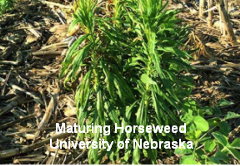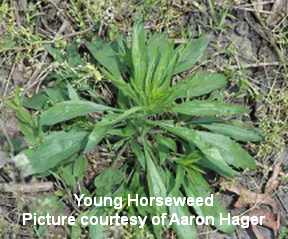AGRONOMICSUPPORT
YOU CAN TAKETO THE FIELD
Fall Herbicide Considerations
With higher fuel costs, smaller margins and increasing weed pressures, many growers are moving away from fall tillage and instead utilizing a fall herbicide program so they don’t have to deal with a mat of winter annual weeds in the spring. Excessive matting of weeds can hamper corn and soybean seedling emergence by retaining soil moisture and preventing soil warm-up. Furthermore, weeds can host various insects that may damage non-treated seed.
Weeds are always easier to control when small, so it makes sense to apply in the early fall to control many winter annual weed species like marestail and butterweed. A colleague of mine always reminds me that, “Trying to control winter annuals in the spring is like trying to control giant ragweed in August!”


Just like in-season, fall application timing is critical. An early October soil-residual typically results in better weed control of winter annual weeds versus later. Conversely, a soil-residual herbicide applied mid-November may be too late to control winter annuals already emerged. Therefore, consider the non-residual herbicides to attack emerged weeds later in the fall.
Despite the rising populations of Waterhemp and Palmer Amaranth, University of Illinois Weed Specialist Aaron Hager does NOT recommend fall application of residual herbicides for control of any spring-emerging annual weed species. Two reasons he avoids recommending fall herbicides to control spring annuals:
- Inconsistent performance: Soil-residual herbicides applied in the fall are greatly dependent on weather and soil conditions after application. Data suggests the greatest and most consistent control of Amaranthus species either at planting or several weeks after planting was achieved when residual herbicides were applied in the spring, not in the fall.
- Increased selection for herbicide-resistant biotypes: Soil-applied herbicides are not immune from selection for herbicide-resistant biotypes. Following a fall application, the concentration of herbicide remaining in the spring when Amaranthus species begin to germinate will be much lower compared with the same product rate applied closer to planting.
Therefore, know your target weeds and identify if you are controlling winter annuals or spring annuals. Winter annual weeds germinate throughout the winter months, so keep in mind that 2,4-D and dicamba do not provide enough residual to keep winter annuals from germinating all winter. Plus, make sure the chemical label gives you the options and flexibility you need for next spring’s crop rotation whether it be LG Seeds Corn or Soybeans.
Resources and additional information:
- https://farmdocdaily.illinois.edu/2018/08/fall-applied-herbicides-which-weed-species-should-be-the-target.html
- https://agfaxweedsolutions.com/2018/09/15/fall-burndown-may-be-even-more-critical-with-early-harvest/
- https://www.ilsoy.org/on-farm/ilsoyadvisor/weed-management-fall-applied-herbicides-which-weed-species-target
Note: The information in this issue is based upon field observations and third-party information. Since variations in local conditions may affect the information and suggestions contained in this issue, LG Seeds disclaims legal responsibility therefore. Always read and follow label instructions. Advantage Acre®, LG Seeds and design are trademarks of AgReliant Genetics, LLC.






Technical Team Agronomist, CPA, CPAg